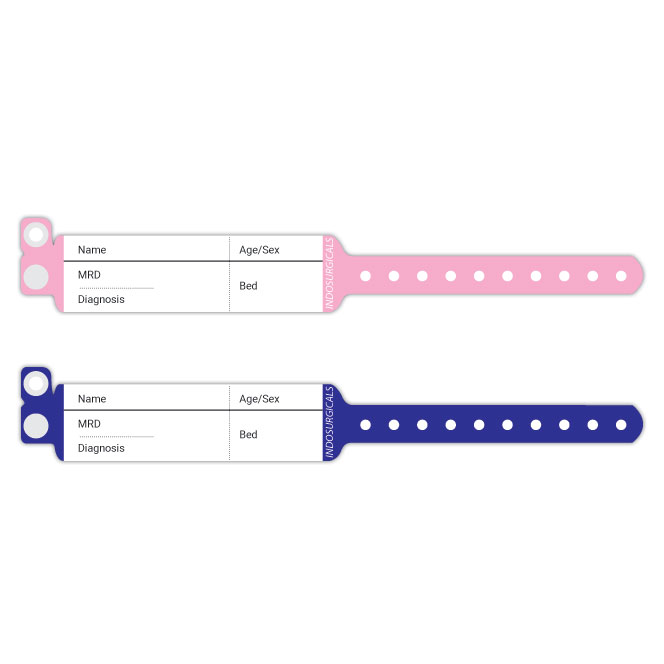The Evolution of the Patient Identification Band in Healthcare Settings
The Evolution of the Patient Identification Band in Healthcare Settings
Blog Article
Checking Out the Different Types of Patient Identification Band Used in Medical Facilities
In the intricate world of medical care, the important role of Patient Identification bands typically goes undetected. These bands, varying from straightforward paper wristbands to advanced RFID bands, create the backbone of Patient safety and security protocols, making certain precision in Patient Identification.
Recognizing the Significance of Patient Identification Bands
While they may appear like plain accessories, Patient Identification bands play a vital role in medical facilities. These bands serve as an important device for validating Patient identification, stopping clinical errors related to misidentification. Patient Identification bands additionally help in simplifying management jobs, making sure precise record-keeping and payment.
Standard Paper Wristbands: Their Use and Limitations
Conventional paper wristbands have been a staple in Patient Identification throughout various clinical centers. While their usage is widespread, they nurture specific constraints that may impact their effectiveness in Patient management. This section will certainly concentrate on the range of their application and the inherent drawbacks related to their usage.
Paper Wristbands: Usage Extent
In the realm of Patient Identification, paper wristbands have long held a critical role. These bands are usually utilized in outpatient setups, where the Patient's keep is temporary. Despite developments in innovation, the modest paper wristband continues to be a cost-effective and reputable option for Patient Identification in different health care circumstances.
Limitations of Paper Wristbands
In spite of their extensive usage, paper wristbands are not without their drawbacks. In enhancement, paper wristbands often do not have the technological capabilities of even more modern choices, such as barcoding or RFID chips, limiting their capability to simply presenting composed details. Paper wristbands can trigger pain or skin inflammation to some people, particularly when put on for prolonged durations.
Barcoded Wristbands: Developments in Patient Identification
While Patient Identification has long been a critical facet of medical care, the introduction of barcoded wristbands signifies a substantial leap ahead. These bands utilize the simpleness of barcoding modern technology, permitting Patient information to be quickly checked and accessed. They enhance the speed and accuracy of Patient Identification, lowering the risk of clinical mistakes associated with misidentification. Barcoded wristbands are economical, very easy to create, and eliminate handwriting mistakes typical with hand-operated systems. They are not without restrictions. While they provide improvements over standard bands, the barcode can end up being smudged or worn, making it unreadable. Despite this, barcoded wristbands continue to be a vital device in contemporary healthcare settings, representing the crossway of technology and Patient care.
Radio Regularity Identification (RFID) Bands: a Step Towards Futuristic Health Care
The development of Patient Identification bands has actually brought about the emergence of Radio Frequency Identification (RFID) Bands (patient identification band). These cutting-edge tools existing essential advantages for healthcare centers, supplying a much more effective and technically advanced methods of Patient Identification. The implementation of RFID in healthcare is a substantial action in the direction of a much more futuristic strategy have a peek at these guys to Patient monitoring and security
Comprehending RFID Bands

RFID Bands: Key Advantages
Largely, these bands improve Patient security by giving accurate, immediate Identification, thereby decreasing clinical mistakes. RFID bands can save a vast amount of Patient information, including medical history and allergic reactions, making it possible for personalized care. Generally, RFID bands stand for a substantial advancement in Patient Identification innovation, benefiting both people and healthcare companies.
Carrying Out RFID in Medical Care
These bands provide a smooth way to track and recognize clients, guaranteeing their security and improving performance in treatment procedures. RFID bands lower medical errors by supplying accurate Patient Identification, which is vital in avoiding misdiagnosis or incorrect medication management. Therefore, the execution of RFID bands is a significant find here action towards boosting Patient safety and security and healthcare distribution.
,aspect=fit)
Color-Coded Wristbands: Assisting in Quick and Accurate Medical Diagnosis
In the busy environment of a clinical center, color-coded wristbands have actually emerged as vital devices for swift and exact Identification of a client's medical problem. These wristbands, put on by individuals, carry certain colors that match to various medical conditions or standings. This system is created to provide instant aesthetic cues to medical care carriers, enhancing Patient safety and security and care quality.
Techniques for Efficient Execution and Management of Patient ID Bands
Accomplishing optimum usage of Patient Identification bands necessitates a well-structured technique for their application and monitoring. The very first step involves training all health workers on the value of appropriately using and reviewing these bands. Second of all, hospitals ought to standardize using ID bands across all departments, making sure harmony and minimizing disparities. Regular audits ought to be conducted to confirm adherence to plans and to fix any kind of incongruities. Patient education is also essential; patients must recognize the objective of the bands and the requirement for their continuous wear. patient identification band. It's important to have a backup strategy in location, such as barcode scanning or biometrics, to ensure that Patient Identification is never ever jeopardized.
Conclusion
Patient Identification bands are crucial in clinical centers to ensure security and precision. Reliable implementation and management of these bands can substantially lower medical errors, increase effectiveness, and boost overall Patient care.
These bands, varying from basic paper wristbands to innovative RFID bands, create the backbone of Patient safety and security protocols, making certain precision in Patient Identification.The evolution of Patient Identification bands has brought about the emergence of Radio Frequency Identification (RFID) Bands. In general, RFID bands stand for a substantial development in Patient Identification technology, benefiting both patients and healthcare carriers.
RFID bands reduce clinical errors by supplying exact Patient Identification, which is important Get More Info in preventing misdiagnosis or incorrect medicine administration. Patient education is also critical; people need to understand the function of the bands and the requirement for their constant wear.
Report this page